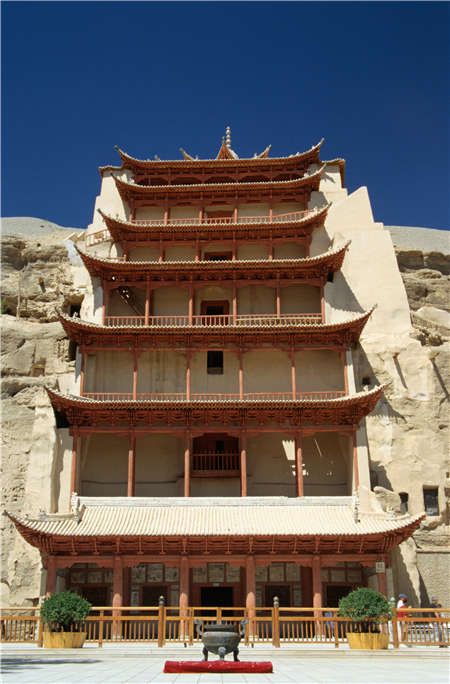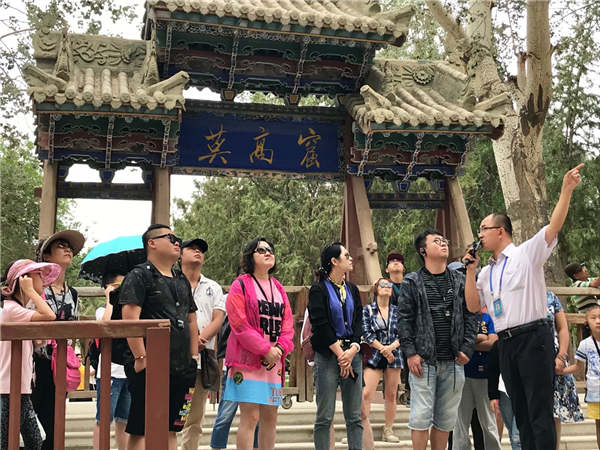
For Bian Lei, a professional guide at the Mogao Grottoes, the site is more a spring than a pond. It offers peace and inspiration to people who are anxious about life in these modern times. [Photo provided to China Daily]
A group of around 150 people now provide guide services in six languages to tourists who visit the famed Mogao Grottoes
(US Commerce News) Bian Lei is 31 years old, and he has visited the Mogao Grottoes, a 1,600-year-old UNESCO World Heritage Site in Dunhuang, Gansu province, more than 5,500 times over the last decade.
As a professional guide at the site, he walks tourists around the many Buddhist sculptures and frescoes there every day.
In his career as a guide, there have been moments when he has had to hold down drunken men while talking about the relics, and when devout Buddhists would go down on their knees and offer flowers and oil at the site, which is not encouraged by management rules.
There were also moments when he has had to describe the shape and color of the statues to the blind; and when a college professor told him: “I am jealous of you because you have the chance to spend so much time with those 1,000-year-old relics every day.”
In peak season, which spans from July to September, he serves about 100 people a day, from 8 am to 6 pm daily.
His salary is about 3,000 yuan ($436), lower than the average wage in Gansu. But Bian says: “I don’t think I can find any job better than this one.
“I feel proud of my job. It’s meaningful,” he adds.
The Mogao Grottoes feature a huge collection of Buddhist art, including more than 2,400 sculptures and 45,000 square meters of frescoes in 735 caves dating back to between 40 and 14 BC.
There are frescoes depicting music bands and dancers performing at a royal court, and flying creatures playing three-stringed lutes known as pipa, among other scenes.
Many of the relics look vivid with well-preserved color due to the dry weather and low rainfall in Gansu.

For Bian Lei, a professional guide at the Mogao Grottoes, the site is more a spring than a pond. It offers peace and inspiration to people who are anxious about life in these modern times. [Photo provided to China Daily]

For Bian Lei, a professional guide at the Mogao Grottoes, the site is more a spring than a pond. It offers peace and inspiration to people who are anxious about life in these modern times. [Photo provided to China Daily]
In 1987, the site was one of the first Chinese ones to be designated a UNESCO world heritage site.
To explain the Mogao Grottoes to tourists, Bian and his colleagues have to read and memorize a wide range of material.
“Tourists come here with many unanswered questions. And our task is to transform the question marks into exclamation marks,” he says.
“For instance, some ask why the area is called the Mogao Grottoes.
“Mogao has several connotations in Chinese – the highland of the desert or the highest place ever.”
Last year, the Mogao Grottoes welcomed 1.73 million visitors, with about 5 to 10 percent being foreigners. And the average daily number of visitors is about 6,000, says Bian.
Speaking about how he relaxes after work, he says: “After returning home I don’t want to talk anymore.”
In 1979 when the Mogao Grottoes were first opened to the public, Dunhuangology experts played the roles of guides. But there are now 150 people today, providing guide services in six languages: Chinese, English, French, German, Japanese and Korean.
Li Yaping, a female guide, is one of those who has been at the site for the past 10 years.
After graduating from college, Li did 50 days of training, before being employed as a guide.
Every day Li walks on the same roads, into the same caves, and speaks the same words, but adds that she does not feel bored.
Agreeing with her description of the job, Bian says: “The Mogao Grottoes is more a spring than a pond. It offers peace and inspiration to people who are anxious about life in these modern times.”

For Bian Lei, a professional guide at the Mogao Grottoes, the site is more a spring than a pond. It offers peace and inspiration to people who are anxious about life in these modern times. [Photo provided to China Daily]
© 2018, biznews. All rights reserved.
